



NFC is the wireless technology used in cards that you can tap to pay for things, open doors, or take out library books. Learn about the physics behind NFC technology and discover what's inside a "tap-to-pay" transit card. Finally, use NFC stickers to make items like binder stickers, keychains, pendants, or jewelry that can interact with cellphones.
This is a teaching module that demonstrates how technology can be mixed with art and fashion. It teaches about how NFC and RFID technology can be used to create keychains, pendants, or other jewelry that can interact with cellphones. Unlike other teaching modules involving hardware or wearable technology, the supplies needed for this module are very affordable, so each student should be able to create their own piece and keep it afterwards.
The module is composed of a presentation that covers the physics principles and engineering that underlie NFC technology followed by an arts & crafts activity where students use NFC tag stickers to create a fashion item that can interact with cellphones. It is expected that the presentation will appeal to older students while the arts & crafts session will appeal to younger students, but hopefully students who are not in the right age category will not feel excluded. Because NFC technology is somewhat obscure, even extremely technology-savvy students will likely learn some new things from the technical content of the talk.
Below are resources that are used for the module:
A presentation on NFC technology and on making keychains, pendants, or other jewelry using NFC tag stickers. The presentation is also available in .odp format.
This is a handout that accompanies the presentation above. It contains some templates that students can use to make some keychains or pendants if they lack the artistic skills to design their own shapes. The handouts also describe how to program NFC stickers to interact with a cellphone.
The presentation on NFC technology includes some demonstrations of physics phenomena. Due to the time involved in setting up such demonstrations, videos of the demonstrations are provided that can be played for the students and discussed with them instead.